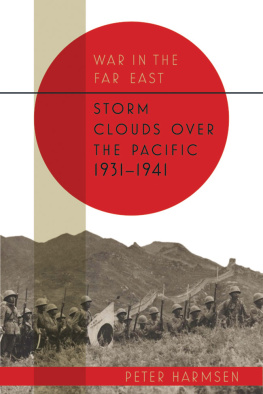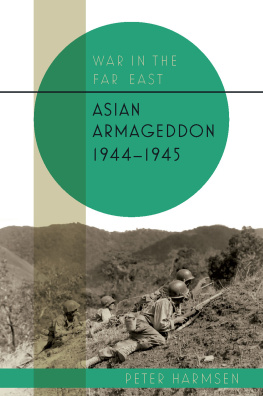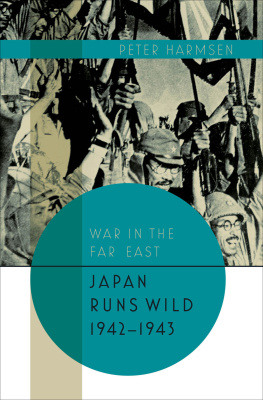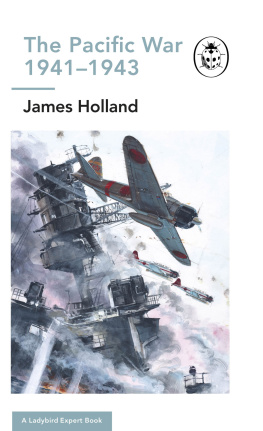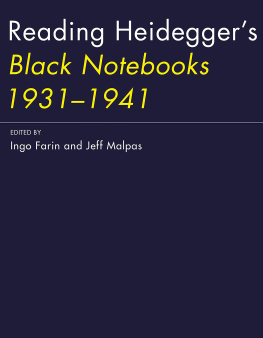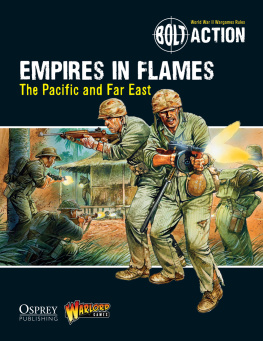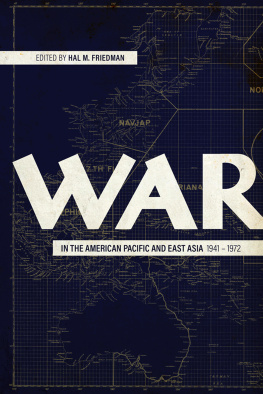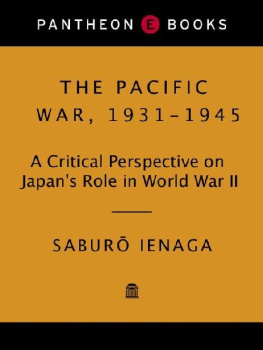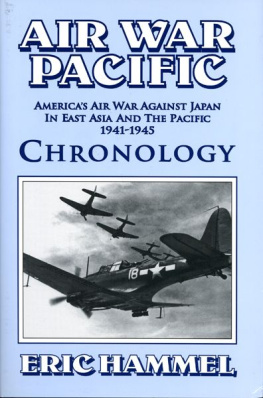Peter Harmsen - Storm Clouds over the Pacific, 1931–1941 (War in the Far East)
Here you can read online Peter Harmsen - Storm Clouds over the Pacific, 1931–1941 (War in the Far East) full text of the book (entire story) in english for free. Download pdf and epub, get meaning, cover and reviews about this ebook. year: 2018, publisher: Casemate Publishers (Ignition), genre: Non-fiction. Description of the work, (preface) as well as reviews are available. Best literature library LitArk.com created for fans of good reading and offers a wide selection of genres:
Romance novel
Science fiction
Adventure
Detective
Science
History
Home and family
Prose
Art
Politics
Computer
Non-fiction
Religion
Business
Children
Humor
Choose a favorite category and find really read worthwhile books. Enjoy immersion in the world of imagination, feel the emotions of the characters or learn something new for yourself, make an fascinating discovery.
- Book:Storm Clouds over the Pacific, 1931–1941 (War in the Far East)
- Author:
- Publisher:Casemate Publishers (Ignition)
- Genre:
- Year:2018
- Rating:3 / 5
- Favourites:Add to favourites
- Your mark:
- 60
- 1
- 2
- 3
- 4
- 5
Storm Clouds over the Pacific, 1931–1941 (War in the Far East): summary, description and annotation
We offer to read an annotation, description, summary or preface (depends on what the author of the book "Storm Clouds over the Pacific, 1931–1941 (War in the Far East)" wrote himself). If you haven't found the necessary information about the book — write in the comments, we will try to find it.
Storm Clouds over the Pacific, 1931–1941 (War in the Far East) — read online for free the complete book (whole text) full work
Below is the text of the book, divided by pages. System saving the place of the last page read, allows you to conveniently read the book "Storm Clouds over the Pacific, 1931–1941 (War in the Far East)" online for free, without having to search again every time where you left off. Put a bookmark, and you can go to the page where you finished reading at any time.
Font size:
Interval:
Bookmark:


Published in the United States of America and Great Britain in 2018 by
CASEMATE PUBLISHERS
1950 Lawrence Road, Havertown, PA 19083, US
and
The Old Music Hall, 106108 Cowley Road, Oxford OX4 1JE, UK
Copyright 2018 Peter Harmsen
Hardback Edition: ISBN 978-1-61200-480-8
Digital Edition: ISBN 978-1-61200-481-5 (epub)
eISBN 978-1-61200-481-5
Kindle ISBN 978-1-61200-481-5 (mobi)
All rights reserved. No part of this book may be reproduced or transmitted in any form or by any means, electronic or mechanical including photocopying, recording or by any information storage and retrieval system, without permission from the publisher in writing.
For a complete list of Casemate titles, please contact:
CASEMATE PUBLISHERS (US)
Telephone (610) 853-9131
Fax (610) 853-9146
Email:
www.casematepublishers.com
CASEMATE PUBLISHERS (UK)
Telephone (01865) 241249
Email:
www.casematepublishers.co.uk
As World War II recedes into history and the number of living witnesses to those momentous events sadly diminishes, the number of historians specializing in the biggest conflict in the history of mankind continues to increase. One advantage of this is the emergence of several international networks of scholars bringing together different approaches and traditions for a more complete understanding of events that continue to reverberate to this day.
In preparing this book, I have been the beneficiary of two such networks. The Second World War Research Group at Kings College London, is a new branch on the rapidly growing tree of international scholarly exchange, and the two conferences I have been able to attend have offered the opportunity for immensely fruitful and stimulating discussions. The same is true for the many international gatherings that the Institute of Modern History at the Chinese Academy of Social Sciences, where I have been fortunate enough to be invited.
Many individuals also contributed to making this volume what it is. Special thanks go to Franco David Macri of the University of Hong Kong and Jokull Gislason of Iceland for reading the manuscript and providing invaluable, detailed feedback. Any errors or omissions in the book are, of course, mine alone. In addition, I wish to thank, for various forms of help, advice, and encouragement, Professor Gao Shihua of the Chinese Academy of Social Sciences, Ricardo Trota Jose of the University of the Philippines Diliman, Zafrani Arifin from Malaysia, and Stephen Hands from Britain.
At Casemate, I have benefited from the tireless support of a dedicated and professional staff headed by group publishing director Clare Litt. Sophie MacCallum edited this volume with an eagle-eyed attention to detail while keeping a keen focus on the overall narrative. I am also indebted to Ruth Sheppard, Isobel Nettleton and Katie Allen for their valuable contributions as the manuscript was turned into a book.
Finally, my family: my wife Hui-tsung once again offered her attention and support, and our two daughters Lisa and Eva were always understanding even during the many evenings and weekends when work on this book required my undivided attention. I suspect their forgiving attitude reflects our common love of books, a passion I am happy to have passed on to them.
Taipei, June 2018
In late summer 1939, a 22-year-old man in the uniform of a Wehrmacht officer was on his way to Germanys border with Poland. His mission was to attach himself to a German division as an observer during the invasion that was only days away. The young man must have attracted considerable attention since his features were anything but Aryan. His name was Chiang Wei-kuo, and he was the adopted son of Chinas leader, Chiang Kai-shek. For the past two years he had undergone advanced military training at the War Academy in the south German city of Munich. In that capacity, he had even taken part in Germanys peaceful occupation of Austria in March 1938.
Chiang Wei-kuos story was a reflection of how close Sino-German ties had grown in the 1930s, as Germanys resurgent armament industry was exporting vast quantities of military equipment to the Nationalist Chinese regime, whose efforts at building up a large modern army were also assisted by a corps of experienced German advisors. The assistance had proved particularly useful since 1937, after full-scale war broke out between China and Japan. By 1939, however, Germany was growing friendlier with Japan and was busy distancing itself from Chiangs regime. As a result, Chiang Wei-kuos presence was beginning to appear out of place, and when he passed through Berlin en route to the Polish border and paid a visit to the Chinese embassy, he received new orders: he was to travel to the United States for military training there.
Consequently, by the time German panzers rolled into Poland in the early hours of September 1, Chiang was already on a ship bound for America, which was emerging as an important new ally for China. He would soon commence studies at the Armored Force Center, Fort Knox, before returning home three years later, his brain filled with the latest military knowledge. He was not the only one in his family to travel widely. His stepbrother Chiang Ching-kuo had spent 12 years in the Soviet Union. He had a Belarusian wife and even a Russian name, Nikolai Vladimirovich Elizarov.
The two stepbrothers formed just a corner of a corner in the immensely complex web of relations and interactions that characterized Chinese and Asian politics and society during the 1930s, the decade that saw the Sino-Japanese War flare up and, little by little, set in motion events which would eventually lead to Japans conflict with an array of Western powers. What the Chiangs do exemplify, however, is the extent to which the war in the Asia Pacific was, right from its earliest origins, a global affair, involving both indigenous actors and actors from thousands of miles away.
The war that raged in and around the Pacific in the first half of the 1940s has traditionally been seen as a struggle pitting the United States against Japan. It is indeed true that the ambitious Japanese Empire was halted, then defeated and destroyed at the expense of primarily American blood. Names such as Guadalcanal, Saipan, and Hiroshima are milestones on the way to Japans complete surrender in August 1945. The contribution of the British in Burma or the Australians in New Guinea are also important, and still remembered.
However, secondary parts were played by a host of other nationalities, some of them appearing in roles largely forgotten by posterity. Examples include Russian exiles in Japanese uniforms acting as auxiliaries in the service of Hirohito in northeast China, or Mexican pilots participating in the liberation of the Philippines. Events in Asia also saw strange alliances, and even stranger enmities. The Vichy French government, under German control, consulted frequently with the US government over developments in Indochina in 1941, and in the same year French forces in Laos and Cambodia found themselves involved in a brief, brutal border war with Thailand.
Just as a deeper understanding of World War II in Asia is gained by involving a wider range of actors than usual, it also makes sense to expand the period under review. This volume, the first in a series of three, does not begin on December 7, 1941. It ends on that day. To appreciate the deep animosities that drove the immensely destructive war and cost the lives of millions of people, soldiers and civilians alike, it is necessary to go decades, indeed centuries, back in time. First and foremost, it is important to explore the strange love-hate relationship between East Asias two oldest civilizations, China and Japan, and how it was conditioned by shifting geopolitical winds, most crucially the arrival of the Western powers from about 1600.
Font size:
Interval:
Bookmark:
Similar books «Storm Clouds over the Pacific, 1931–1941 (War in the Far East)»
Look at similar books to Storm Clouds over the Pacific, 1931–1941 (War in the Far East). We have selected literature similar in name and meaning in the hope of providing readers with more options to find new, interesting, not yet read works.
Discussion, reviews of the book Storm Clouds over the Pacific, 1931–1941 (War in the Far East) and just readers' own opinions. Leave your comments, write what you think about the work, its meaning or the main characters. Specify what exactly you liked and what you didn't like, and why you think so.

